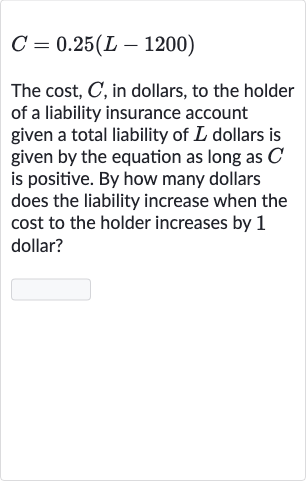AI tutor
Welcome to Bytelearn!
Let’s check out your problem:

The cost, , in dollars, to the holder of a liability insurance account given a total liability of dollars is given by the equation as long as is positive. By how many dollars does the liability increase when the cost to the holder increases by dollar?
Full solution
Q. The cost, , in dollars, to the holder of a liability insurance account given a total liability of dollars is given by the equation as long as is positive. By how many dollars does the liability increase when the cost to the holder increases by dollar?
- Isolate L in equation: We are given the equation , where is the cost to the holder and is the total liability in dollars. We need to find out how much increases when increases by dollar.First, let's isolate in the equation to see how it changes with respect to .
- Add to both sides: We add to both sides of the equation to get .
- Divide by . to solve: Next, we divide both sides of the equation by to solve for . This gives us .
- Find change in : Now, we want to find out the change in when increases by dollar. Let's call the increase in as and the increase in as . Since is dollar, we can write the new cost as .
- Substitute : Substituting into the equation for , we get .
- Solve for : Since is , we can substitute it into the equation to get .
- Substitute into equation: We can now subtract the original from both sides to find . This gives us .
- Simplify the equation: We know that from our earlier step, so we can substitute this into our equation for . This gives us
- Calculate : Simplifying the right side of the equation, we see that the terms cancel out, leaving us with .
- Final result: Calculating gives us . This means that the liability increases by dollars when the cost to the holder increases by dollar.
More problems from Write linear functions: word problems
QuestionGet tutor help
QuestionGet tutor help
QuestionGet tutor help
QuestionGet tutor help
QuestionGet tutor help
QuestionGet tutor help
QuestionGet tutor help
QuestionGet tutor help
QuestionGet tutor help
